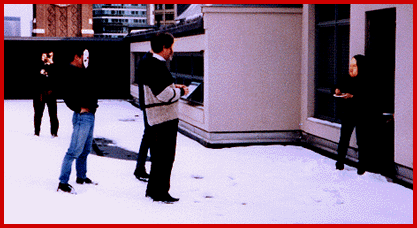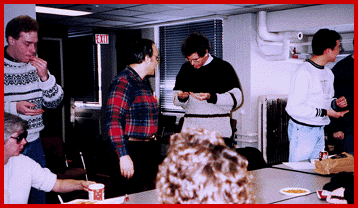 Setsubun - Around February 3
Setsubun - Around February 3 Setsubun - Around February 3
Setsubun - Around February 3
![]() What's the meaning of this event?
What's the meaning of this event?
In the old lunar Japanese calendar, each season had its own day (called
Setsubun) to mark the change of the season. In the old calendar, the
first day of spring (rissyun) was considered to be the start of the New
Year, so the Setsubun at the end of winter was the last day of the
year, and had special customs. Today it is the only Setsubun still
celebrated. In the modern calendar, it occours around February 3 or 4.
Today, various local family customs and manners of celebrating Setsubun still exist. All the customs are events suitable for greeting the New Year: driving out evil, and wishing for good fortune in the coming year.
![]() What do people do on this day?
What do people do on this day?
On the evening of Setsubun, generally, an oni-uchi
(devil-extermination) and mame-maki (bean-scattering) ceremony
is held. Before nightfall people saute soybeans without oil, and in
the evening, throw soybeans inside and outside of the house saying
"Oni wa soto. Huku wa uchi! (Out with the devil! In with good
fortune!)" in order to drive out any bad spirits. Also, people throw
soybeans at another person wearing a devil mask as a kind of fun.

In a related custom, many people make a meal of the remaining soybeans with each person eating one bean for each year of their age.

Another Setsubun custom is to eat grilled sardines and mount the leftover heads on holly twigs, and set them next to the front door of the house. This will frighten away any demons atempting to enter. Depending on the area, garlic or another strong-smelling material is sometimes used instead of sardine heads.
In the Kansai area, some people also observe Setsubun by eating an uncut sushi roll (maki-zushi) while facing towards this year's "lucky direction." This direction depends upon the zodiac sign of the year. For instance, 1996, the year of the mouse, the direction was south-south-east. On this one day, sushi shops don't cut their sushi rolls, but leave them whole.
![]() Are there objects associated with this event?
Are there objects associated with this event?
 Oni no men (Devil's mask)
Oni no men (Devil's mask)
 Mame (Soybeans)
Mame (Soybeans)
![[Jan]](../pictures/Jan.gif) ![[Feb]](../pictures/Feb.gif) ![[Mar]](../pictures/Mar.gif) ![[Apr]](../pictures/Apr.gif) ![[May]](../pictures/May.gif) ![[Jun]](../pictures/Jun.gif) ![[Jul]](../pictures/Jul.gif) ![[Aug]](../pictures/Aug.gif) ![[Sep]](../pictures/Sep.gif) ![[Oct]](../pictures/Oct.gif) ![[Nov]](../pictures/Nov.gif) ![[Dec]](../pictures/Dec.gif) |
![[JP NET Home]](http://web.mit.edu/jpnet/graphics/jpnethome.gif)
|
Date last modified: Tuesday, 05-Mar-2002 16:50:01 EST
Copyright 2002 Massachusetts Institute of Technology
This page's URL: http://web.mit.edu/jpnet/holidays/Feb/setsubun.shtml
Report any problems with this website here.